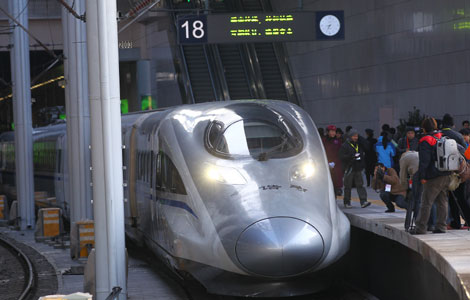
The launch of the world's longest high-speed rail route from Beijing to Guangzhou, in South China, promises to reshape the country's logistics landscape with the release of huge cargo transport capacity.
More passengers traveling between the two cities are expected to opt for the new service, freeing traditional trains for cargo transport.
China put the 2,298-km Beijing-Guangzhou high-speed line into test operation on Saturday.
According to an earlier announcement by the Ministry of Railways, the service will open on Wednesday and is expected to cut traveling time between the two cities to eight hours from about 20.
It is estimated that 20 million metric tons of cargo transport capacity will be released on the Beijing-Wuhan section of the old Beijing-Guangzhou rail route after the high-speed service starts, people.com.cn reported.
The Beijing-Guangzhou route is mainly used for passengers, but once the high speed service operates, the old route will be able to run more cargo trains, increasing transportation capacity for commodities such as coal, steel, rice, oil and ores, wrote Chu Hai, an analyst with Ping'an Securities.
"Closing a passenger train can add transport capacity of 1.5 to 2 cargo trains. In addition, cargo transportation is more profitable," Chu wrote.
A report by People's Daily in August 2010 showed 85 percent of the nation's timber, 85 percent of its crude oil, 60 percent of coal and 80 percent of iron and steel are transported by rail, but due to inadequate transport capacity, less than 35 percent of these resources can be allocated to trains at a time.
"After the opening of the Wuhan-Guangzhou high-speed railway, we shipped 28 percent more coal out of Pingdingshan in the first five months of 2010 from a year earlier," Chen Qiao, deputy general manager of the logistics division of the Wuhan Iron and Steel Corp, was quoted by People's Daily as saying.
Chen said more than 10 coal-fired power plants lie along the Wuhan-Guangzhou section, or the southern section of the Beijing-Guangzhou route, consuming about 30 million tons of coal a year, but only half of the coal can be transported by rail.
After the Wuhan-Guangzhou high-speed rail service began, about 33 pairs of cargo trains, or 3,960 carriages, were added to the railway, increasing transport capacity by 87.6 million tons annually.
With complete operation of the Beijing-Guangzhou high-speed railway, the strain on cargo transport is expected to ease, according to some analysts.
 Kitty encounter
Kitty encounter
 Bumper crops mean China can feed itself
Bumper crops mean China can feed itself
 Snow sculptures, a blessing for those braving cold weather
Snow sculptures, a blessing for those braving cold weather
 Winter fishing festival marked in NE China
Winter fishing festival marked in NE China
 Railway to create network of 'city clusters'
Railway to create network of 'city clusters'
 Have fun with Tmall's Lego mascot
Have fun with Tmall's Lego mascot
 Playing at Ice and Snow World in Harbin
Playing at Ice and Snow World in Harbin
 Santa is coming and China takes more notice
Santa is coming and China takes more notice